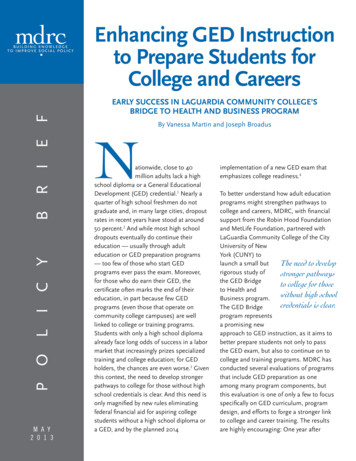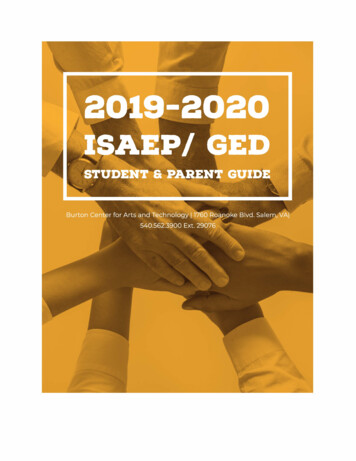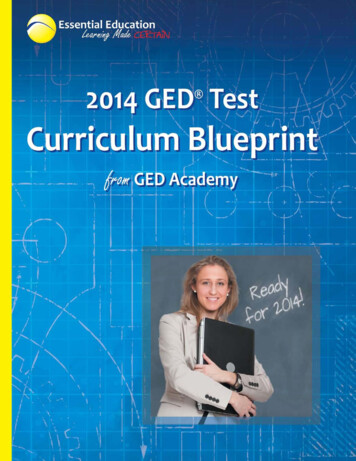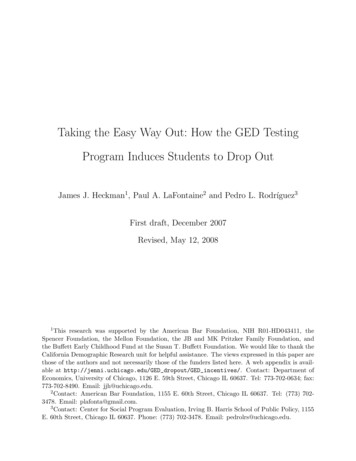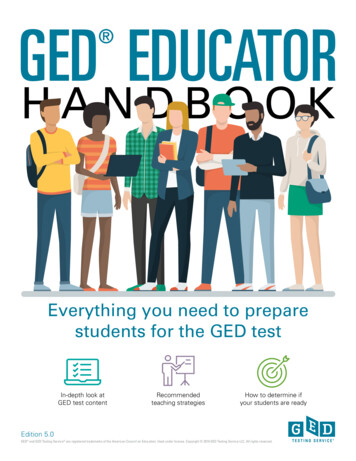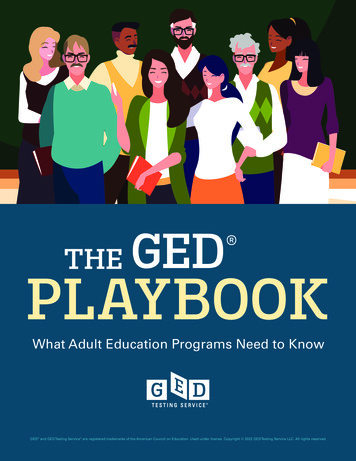
Transcription
THEGED PLAYBOOKWhat Adult Education Programs Need to KnowGED and GED Testing Service are registered trademarks of the American Council on Education. Used under license. Copyright 2022 GED Testing Service LLC. All rights reserved.
IntroductionAt GED Testing Service, we have helped over 20 million students achieve highschool equivalency and pursue a brighter future.The GED program is more than a diploma. It’s a program for students to developskills that lead to success in higher education and career growth. We strive toempower all students to improve their lives through education.While there are certain misconceptions associated with the GED credential, itis our goal to help you inform your students that with commitment, preparation,practice, and study, they can become GED grads.This GED Playbook for the Adult Education Program Directors, Managers,and Instructors is intended to assist in navigating and understanding the GED program. We hope this will be a good starting point as you learn how to betterserve your adult learner. If you have any questions, please reach out to yourState GED Administrator or your GED State Relationship Manager (SRM).HistoryWe are GED Testing Service, the sole provider of the official GED test. We’vehelped over 20 million people achieve their GED credential. We are the onlyhigh school equivalency program that is recognized by 97% of employers andcolleges nationwide.GED Testing Service is a joint venture of the American Council on Education,which started the GED program in 1942, and leading education company,Pearson.2
Table of contentsWho should use the GED Playbook? . . . . . . . . . . . . . . . . . . . . . . . . . . . . . . . . . . 5The GED Testing Service organization . . . . . . . . . . . . . . . . . . . . . . . . . . . . . . . . 5College Readiness. . . . . . . . . . . . . . . . . . . . . . . . . . . . . . . . . . . . . . . . . . . . . . . . . 6Career Readiness and Workforce Development. . . . . . . . . . . . . . . . . . . . . . . . . 6Typical program structure . . . . . . . . . . . . . . . . . . . . . . . . . . . . . . . . . . . . . . . . . . 7How is the typical GED Program structured?. . . . . . . . . . . . . . . . . . . . . . . 7What are the duties of an Adult Education Program Manager andProgram Director? . . . . . . . . . . . . . . . . . . . . . . . . . . . . . . . . . . . . . . . . . 8National Reporting and Assessment References. . . . . . . . . . . . . . . . . . . . . 9Wraparound Services. . . . . . . . . . . . . . . . . . . . . . . . . . . . . . . . . . . . . . . . . . 9Getting to know the GED test. . . . . . . . . . . . . . . . . . . . . . . . . . . . . . . . . . . . . 10What is the GED test? . . . . . . . . . . . . . . . . . . . . . . . . . . . . . . . . . . . . . . 10What are the parts of the GED test? . . . . . . . . . . . . . . . . . . . . . . . . . . . 11Data: GED Test Takers Over the Past 7 Years. . . . . . . . . . . . . . . . . . . . . . . 11Getting started as a teacher . . . . . . . . . . . . . . . . . . . . . . . . . . . . . . . . . . . . . . . 11What are the duties of a GED teacher?. . . . . . . . . . . . . . . . . . . . . . . . . . . 11What skills does it take to be an effective teacher?. . . . . . . . . . . . . . . . . . 12Program Profiles: Student orientation and recruitment. . . . . . . . . . . . . . . 13Sample: Adult Education Orientation Process as a Best Practice . . . . . . . 14Checklist for Student Enrollment. . . . . . . . . . . . . . . . . . . . . . . . . . . . . . . . 15Self-Assessment for Adult Education Instructors . . . . . . . . . . . . . . . . . . . 163
Content and Support. . . . . . . . . . . . . . . . . . . . . . . . . . . . . . . . . . . . . . . . . . . . . 17Areas of Instructional Focus for each Content area Test . . . . . . . . . . . . . . 17GED Testing Service Professional Development Initiative. . . . . . . . . . . . . 19Diversity, Equity, and Inclusion . . . . . . . . . . . . . . . . . . . . . . . . . . . . . . . . . 20GED Test Prepped Program . . . . . . . . . . . . . . . . . . . . . . . . . . . . . . . . . . 20GED READY Practice Test . . . . . . . . . . . . . . . . . . . . . . . . . . . . . . . . . . . . 22Resources of GED.com. . . . . . . . . . . . . . . . . . . . . . . . . . . . . . . . . . . . . . . . . . . . 23GED Marketplace —Offering More High School Equivalency TestPreparation. . . . . . . . . . . . . . . . . . . . . . . . . . . . . . . . . . . . . . . . . . . . . . 23GED Direct (The GED Ready Practice Test – GED). . . . . . . . . . . . . . . . 23Customer Service for Examinees . . . . . . . . . . . . . . . . . . . . . . . . . . . . . . . 24Useful Links. . . . . . . . . . . . . . . . . . . . . . . . . . . . . . . . . . . . . . . . . . . . . . . . 24Appendix. . . . . . . . . . . . . . . . . . . . . . . . . . . . . . . . . . . . . . . . . . . . . . . . . . . . . . . 27Teacher Checklist: Getting ready for your GED class. . . . . . . . . . . . . . . . 27Sample: Student Work Folder Check List. . . . . . . . . . . . . . . . . . . . . . . . . . 28References. . . . . . . . . . . . . . . . . . . . . . . . . . . . . . . . . . . . . . . . . . . . . . . . . . . . . . 29Acknowledgments. . . . . . . . . . . . . . . . . . . . . . . . . . . . . . . . . . . . . . . . . . . . . . . 294
Who should use the GED Playbook?Within this document you’ll find several helpful resources and tips. Below we’veoutlined who this Playbook serves.Adult Education Program Directors and Managers Those who oversee and manage the GED adult education programsTeachers and Tutors Those who provide prepare and plan lessons and are employed by GEDeducation programs or community-based (teachers) Those who work independently and provide one-on-one instruction to GEDstudents (tutors)The GED Testing Service organizationACEGEDTSWFSPearsonVUEAmerican Council on Education (ACE) – A non-profit organization that is themajor coordinating body for US colleges and universities and one of the parentorganizations, along with Pearson, of the GED Testing Service joint venture.Back to Table of Contents5
Pearson – Is an integrated business that brings together digital content,world-renowned assessments and high-quality learning service that supportcustomers.GED Testing Service (GEDTS) – Is the developer and owner of the GED test,the GED program and is organized within Pearson’s Workforce Skills division.Workforce Skills (WFS) – A business division within Pearson responsible forassessment that supports career progression, helps people unlock their talentand drives growth for our customers’ businesses.Pearson VUE – Pearson’s computer-based testing business unit that providesthe advanced and reliable electronic testing system for delivering the computerbased GED test.College ReadinessGED grads are better prepared than ever for post-secondary education and job/career training programs. Since 2014 a higher percentage of GED graduates areattending college programs, are enrolling more quickly, and they’re succeedingthanks to GED college readiness resources.Career Readiness and Workforce DevelopmentThe GED program helps adult learners earn a meaningful high schoolequivalency credential and be better prepared for future career opportunities. Italso helps states and local programs deliver on their Workforce Innovation andOpportunity Act (WIOA) outcomes and metrics.Career Readiness and Workforce Development offers individualsopportunities to be more productive and prosperous in the workplace,which benefits both the employer and the worker. Learners can growskills and have access to tools they need for workplace success.Back to Table of Contents6
Accelerated Pathways — Pearson Accelerated Pathways provides flexibledegree and post-secondary options for students as well as strategiceducation benefits for corporations looking to future-proof their workforce Credly — Leading the digital credential movement, Credly is a digitalbadging platform that offers the most comprehensive features to designand issue badges, enterprise-class functionality to scale and manageprograms. TalentLens — Pearson TalentLens offers soft skill assessment solutionsfor corporate recruitment and lifelong career development. Soft Skills arehighly relevant to understanding a person’s strengths, growth opportunitiesand development areas and are predictive of job fit and ultimately,performance in a role. Julius Education — *This program is currently in the pilot phase. JuliusEducation provides skills that companies want and industry-recognizedcertifications for STEM and Green jobs, combined with personalized careerdiscovery for learners. Instructors receive workforce related lesson plansdesigned to support NRS level gains & IET components.Typical program structureHow is the typical GED Program structured?There are hundreds of GED programs nationwide that provide opportunities forlearners to earn a high school diploma credential but they vary from organizationto organization. The typical program will have a leadership team that includesa Director or Manager. They may also have program staff consisting of intake/registration staff, instructional coaches and instructors. Many programs may alsohave paid and/or volunteer tutors. Below are roles in a typical GED program: Student Intake Assessment staffBack to Table of Contents7
PreGED and GED instructors Student interventions team (counselors, advisors, etc.) Instructional coaches Coaches to help students with persistence, motivation Post-testing staff Staff to help students transition from GED program to workforce orindustry credential or post-secondary educational programWhat are the duties of an Adult Education Program Manager andProgram Director?The job of a GED program director or manager is challenging. They are primarilyresponsible for providing leadership and planning for the educational program.Those responsibilities typically include hiring program staff and instructors,providing guidance to staff, and handling challenges and complaints. Here are tentips to help cultivate the best program staff: Hire people who are enthusiastic about helping adult reach theiracademic goals When hiring instructional staff, use assessments to determinetheir competency Allow instructors to teach to their content area strengths Standardize instruction with a written curriculum and use a standard lessonplanning template Use program data to make decisions about instruction, staffing,classes, etc. Provide support to staff, esp. teachers; listen to their concerns andtake actionBack to Table of Contents8
Provide support to students; listen to their concerns about their learningand take action Assess program regularly and make changes where necessary Conduct student surveys regularly to assess student satisfaction Provide and require annual professional development in teaching strategiesfor academic content concepts.National Reporting and Assessment ReferencesNRS Educational Functioning Levels is the accountability system for Federallyfunded adult education programs. NRS provides technical assistance and trainingto States to meet the needs of State and Local programs.Assessments such as CASAS and TABE are nationally recognized tests thatmeasure the academic progress of adult education students in the areas ofmath, reading, listening, speaking, writing, etc. These assessments helpprograms monitor students’ progress using pre and post-tests.Below are other assessment resources for your reference. CASAS (Comprehensive Adult Student Assessment System) TABE (Academic Assessment Tool) Best Plus 2.0 (ESL)Wraparound ServicesWhat are wraparound services? Wraparound is often defined as a strengthbased approach focused on assisting adult learners in addressing barriers to goalcompletion in a comprehensive, holistic, and supportive manner. Individualizedservices tailored to meet individual need is important.Why provide wraparound services? Many adult learners face barriers in their livesthat adversely impact their ability to complete their educational and career goals.Back to Table of Contents9
Barriers can be situational or institutional. Situational barriers are of particularimportance. These types of barriers include but are not limited to the following:lack of or low-income, living situation, lack of reliable and affordable childcare,community setting, family responsibilities, and lack of motivation. Wraparoundservices are needed to help adult learners overcome barriers and continue theirjourney to each educational and career success.How to implement wraparound services? It takes resources, coordination,collaboration, and commitment to provide wraparound services. Many AdultEducation programs have the commitment but are not equipped to provide otherwraparound supportive services. Programs should identify and partner withgovernmental agencies, community-based non-profits, and faith-based programsin providing wraparound services.Examples of types of wraparound services: Case management (can be identified during the orientation/intake process) Career counseling Financial/Childcare/Transportation assistance (Department of HumanResources) Disability support (Vocational Rehabilitation Services) Homeless support (Shelters and agencies)Getting to know the GED testWhat is the GED test?The GED Test is an assessment measuring the enduring academic outcomesof a high school education. Taking and passing the GED test is a vehicle to helpstudents who have not completed a regular high school course of study to earna high school equivalency credential, which in turn facilitates participation inpostsecondary education or careers.Back to Table of Contents10
What are the parts of the GED test?The GED test is made up of 4 separate content tests (representing theacademic areas of English language arts, mathematics, science, and socialstudies). The tests are independent and may be taken individually at any time. Foran overview on each content area, visit GED.com/about test/test subjects/.Data: GED Test Takers Over the Past 7 YearsSince the inception of the new GED test series5,600,000adults worldwidetook at least one of the four GED content areatests. Students must score at least 145 in allfour content areas to earn their GED credential.The total number of test takers is 5,604,593.This number includes all students who havetaken at least one content area of the GED testregardless of whether they completed or metthe GED test passing score.Since the inception of thenew GED test series7,747,728total GED testshave been taken.Since the launchof the 2014 seriesof the GED test1.1 Millionhave recieved a credential.Getting started as a teacherWhat are the duties of a GED teacher? Deliver lessons in multiple formats (in-person, online, hybrid), as needed Connect with students through meaningful conversations Use classroom management skills to maintain an interactive learningenvironmentBack to Table of Contents11
Monitor students’ progress using assessments Provide guidance to students concerning their educational and career goals Complete annual professional development requirements to maintainproficiency Stay abreast of current technology related to remote instruction Conduct regular reflections to assess lesson preparation, delivery,effectiveness, etc. Regularly communicate with program, colleagues, students via email and/or textsSee “Teacher Checklist: Getting ready for your GED class” in the appendix formore information.What skills does it take to be an effective teacher? Enthusiasm about teaching and learning Background in education and training (proficiency) Understanding student engagement, persistence, soft skills, and upskills Understanding of Adult Education Theory Ability to teach to all different backgrounds: low skilled students, learningdisabilities, students of different cultures and those with language barriers,etc. Ability to teach in the GED content areas of math, reading and writing,social studies, science Comfortable with technology; eager to learn new technological apps andinteractive practices for remote instruction Eager to help adults reach their educational goals Excellent organizational skills (required)Back to Table of Contents12
Excellent communication skills, both verbal and written (required)See “Self-Assessment for Adult Education Instructors”.Program Profiles: Student orientation and recruitment.It is highly recommended that programs offer all adult education students with astructured orientation/intake process. This process can be for Open enrollment orManaged enrollment classes.The following is a general summary of student intake: Orientation— Prospective students receive an overview of the GED test, anoverview of the Adult Education Program, and complete a diagnostictest. Testing— Students complete mandatory assessments, complete AdultEducation Program paperwork, goal setting, and advising.In some cases, students who score high on the assessment tests can bedirected to complete the GED Ready test to determine their readiness for theofficial GED test. Development— Subsequently, students are placed in either a Pre GED class or aGED class based on their assessment scores (e.g. CASAS or TABE).Students complete an assessment with their instructors whichhelps the teachers determine the students’ academic strengths andweaknesses.Back to Table of Contents13
Sample: Adult Education Orientation Process as a Best PracticeTypes of Orientation: In-person Orientation – The GED student will attend an Orientation sessionwith the instructor at a designated time.— The students will be completing paperwork (forms/policy agreements)at the program location or class site UNLESS they are 100% distancelearning. Online Orientation – The GED student will attend an online orientationprocess for distance learning.— The students will complete the required forms online.Each GED Candidate and Applicant will be contacted by phone/email and askeddesignated questions that will determine the type of Orientation in which to beenrolled: What campus location can you attend class? Do you need morning or evening classes? What program of study are you interested in? What type of device (Computer/smartphone/tablet) do you have? Have you been enrolled with our Adult Education Program within the lastyear?— If the student has been enrolled with our program within one calendaryear, the student will be sent directly to the instructor.Orientation Session Best Practices: Provide a clean and well-organized room that is welcoming andcomfortable.Back to Table of Contents14
Perform activities that will allow students to get to know each other to builda feeling of community. Provide a thorough program overview. Prepare orientation folders before the session date. Make sure you haveone for each student. Avoid assessment testing on the first day, if possible. Provide each student with a certificate of completion for attending theorientation session.Checklist for Student EnrollmentThe following data is collected during the typical GED intake session. This datacan assist instructors in learning about their students, targeting their instructionalneeds, and identifying their goals.Sample of student work folder checklist:3 Enrollment Data Form3 Assessment Score Report (Pre and Post)3 GED Ready Practice Test scores and Score Report3 Student’s Acknowledgement of Program’s Attendance and AssessmentPolicies3 Student’s Goals Sheet3 Student’s Barriers to Success3 Learning Styles Inventory3 Plan of Instruction (POI)3 Career Inventory/AssessmentBack to Table of Contents15
Self-Assessment for Adult Education InstructorsUse this short assessment to help determine if becoming an Adult Educationinstructor is a good-fit for you. The assessment will also help you identify yourstrengths and weaknesses. You can also use this to help develop your personalprofessional plan to help you excel as an adult education instructor.CompetencyThis is new tomePedagogy (teaching andlearning)Adult Learning TheoryPlanning lessons foradults: Effective lessonplanning for adultsDifferentiated instructionContextualize lessonCharting my ownprofessionaldevelopment to grow asan instructorExperience with currenttechnology and abilityto effectively use thosetechnologies duringinstructionBack to Table of Contents16This is aweakness formeI am strong inthis area
Content and SupportAreas of Instructional Focus for each Content area TestReasoning Through Language ArtsAssessment Guide for Educators: Reasoning Through Language Arts (RLA)Professional Development webinars Reading to Learn – Strategies to Build Reading Skills for the GED Test Hitting the Mark – Taking a Deeper Dive Into Reading Close Reading: A Key to Teaching Constructed Response Moving Up! Building Better Writing Skills What Students Need to Know GED RLA’s Extended Response Taking the Angst Out of Scoring the GED RLA Extended Response Thinking Strategies for Crafting Constructed Response (Part 1) Thinking Strategies for Crafting Constructed Response: One Step at a Time (Part 2)Mathematical ReasoningAssessment Guide for Educators: Mathematical ReasoningProfessional Development webinars Mathematical Reasoning What’s the Problem with Inequalities Math Functions – Why Do I Need to Know About Them Mathematical Reasoning Improving Students’ Mathematical Problem Solving Skills Making Mathematical Thinking Processes VisibleBack to Table of Contents17
ScienceAssessment Guide for Educators: ScienceProfessional Development webinars From the Headlines! Big Ideas in Science How Do I Display That? Tips & Resources for the GED Science Classroom Scientific Minds Want to Know: Strategies for Addressing High Impact Areas of the GED ScienceTestSocial StudiesAssessment Guide for the Socials StudiesProfessional Development webinars Enduring Issues and Making Connections in Social Studies Teaching Social Studies Through Political Cartoons Read Like a Historian: Differentiating Instruction – One Size Doesn’t Fit All!Back to Table of Contents18
GED Testing Service Professional Development InitiativeProfessional Development for GED instructors is continued participation ininstructional and professional activities that help to advance the effectiveness ofinstructors and improve learner outcomes. The goal of Professional Developmentshould always be to learn and develop new skills, increase awareness of currenttrends, and promote growth and advancement in the area of teaching andlearning in adult basic education.GEDTS’s Professional Development Initiative delivers instructional content andteaching strategies to a wide audience of adult educators through multipledelivery formats.The identified priorities for the Initiative, and corresponding activities are listedbelow: Tuesdays for Teachers:— https://ged.com/educators admins/teaching/professional development/webinars GEDTS Professional Development Road Shows:— These are full-day, content-rich professional development trainingsessions conducted by the GED State Relationship Manager and/or consultants in multiple venues across the states. The intense,hands-on sessions provide onsite teaching and learning opportunitieswith materials of instruction to take away for immediate use in theclassroom. Engagement at State and National Conferences and Events:— The GED State Relationship Manager delivers workshops and attendsstate meetings and national conferences.Back to Table of Contents19
Diversity, Equity, and InclusionDeveloping an inclusive philosophy and environment for students is critical.Instructors should envision an educational system in which equity andinclusion are part of the entire framework and then structure their classroomsand practices along these principals to encourage success for learners of allbackgrounds.The appropriate mindset precedes anything that a student will face related tocurriculum. Mindfulness should run across all components of the program toenable the discovery of external surface needs, as well as internal emotionalneeds. These pillars of mindfulness challenge barriers and help to foster the ideathat the whole person shows up, they are included and feel as if they belong sothat they can then turn their attention to their aspirations. Being inclusive doesnot require instructors to fully grasp the background and life experience of eachof their students. However, sensitivity, curiosity, and open-mindedness can bringabout a sense of belonging within the GED classroom.BelongingnessWorthinessCompetenceGED Test Prepped Program*This program is currently in development.Coming soon – Educators will learn from a one-hour Coaching Webinar aboutTest Mastery, the assessment, the student Profile and how to help their studentswith their Test Mastery.Back to Table of Contents20
Test Mastery MindsetMore thought has to be given to our mindset and how a positive mindset canset us up for success. Our students are no different and most would agree thata student’s testing mindset has a significant impact on how they score on theGED test. A student’s mindset powers their Test Preparation and Test Readinessbehaviors, and these behaviors lead to test-taking outcomes and results.Copyright FifthTheory, LLCSource: FifthTheoryTest Mastery: Test Preparation Test ReadinessTest Preparation competencies are associated with how thoroughly andeffectively one will prepare for the GED test. Test Readiness competenciesare associated with how a test taker will behave on the day of the test. The TestPreparation is comprised of Motivation and Responsibility dimensions. The TestReadiness is comprised of Confidence and Resiliency dimensions. Each of thesedimensions’ further breakdown to 16 discrete competencies.MOTIVATION: Committed, Studious, Productive & Energetic.RESPONSIBILITY: Organized, Time-Efficient, Self-Disciplined & Assertive.Back to Table of Contents21
CONFIDENCE: Mentally Tough, Self-Assured, Internally Controlled & Attentive.RESILIENCY: Optimistic, Centered, Composed & Quality-Oriented.Source: Fifth TheoryGED READY Practice TestThe GED Ready is the official GED practice test. The score received on the GEDReady predicts the likelihood of passing the GED official test. If the score is“Likely to Pass”, then encourage your student to take the GED test within thenext two weeks in order to pass the GED test. The questions are created in thesame method as those on the GED test and use the same format. GED Readyscores fall into one of three categories, helps to discover areas of improvement,and the GED Ready score report is a study plan that identifies the skills neededto study to pass the GED test.Not Likely to PassToo Close to CallLikely to Pass100–133134–144145–200If the score is “Not Likely to Pass”,then encourage your student to keepstudying, use the resources availableunder the study tab in their GED.comstudent account, and attempt to retakethe GED Ready test.Back to Table of Contents22
Resources of GED.comGED Marketplace —Offering More High School Equivalency Test PreparationGED Marketplace offers educators and test-takers an online store full of studyguides, practice tests, and other preparation materials created by some of thebest GED test prep companies.GED Marketplace features: Online courses Corrections specific prep materials GED test vouchers Teacher resources Test prep and study books Computer skills training Prep packages College readiness resources GED Ready Workplace trainingGED Marketplace provides a one-stop shop for preparation materials, all on asafe and secure place to start GED test-takers on the road to success. Sixteenpublishers are currently featured on GED Marketplace, and this number will onlyincrease. The materials are available in English and Spanish, and adult learnerscan pick from a variety of modes, including online curricula, traditional textbooks,and practice tests. A list of publishers that have test preparation materials forthe GED test can be found at https://ged.com/educators admins/teaching/prepproducts.GED Direct (The GED Ready Practice Test – GED)GED Direct is a GED Ready managing tool only available to educators that haveaccess to GED Manager*. With access; you can assign GED Ready practicetests directly to your students. Buy all the GED Ready tests you need for yourprogram and share them with your fellow educators so each of you can assign atest as soon as your student is ready. No voucher codes to manage or hand outBack to Table of Contents23
to your students. Once assigned, the student will see the GED Ready in theiraccount and can take it immediately.*Not all GED Manager users have permission to use this tool. If you areinterested, please contact the State GED Administrator to find out if you areeligible to participate.Customer Service for ExamineesRegistration and scheduling customer service options: Email: Test-takers can email help@GED.com with questions or to requesthelp in signing up, scheduling, or changing test appointments. Customer Support Center: Test-takers can sign up for and schedule theirGED tests by calling 1-877-EXAM-GED (392-6433). The toll-free test-takerassistance call center hours are Monday through Friday, 8:00 a.m. to 8:00p.m. Eastern Time.Useful LinksRequest GED Manager access: https://ged.com/educators admins/test admin/ged manager/gedmanager request form/Access Guide: https://ged.com/wp-content/uploads/gedmanager
Back to Table of Contents 6 Pearson - Is an integrated business that brings together digital content, world-renowned assessments and high-quality learning service that support customers. GED Testing Service (GEDTS) - Is the developer and owner of the GED test, the GED program and is organized within Pearson's Workforce Skills division. .



